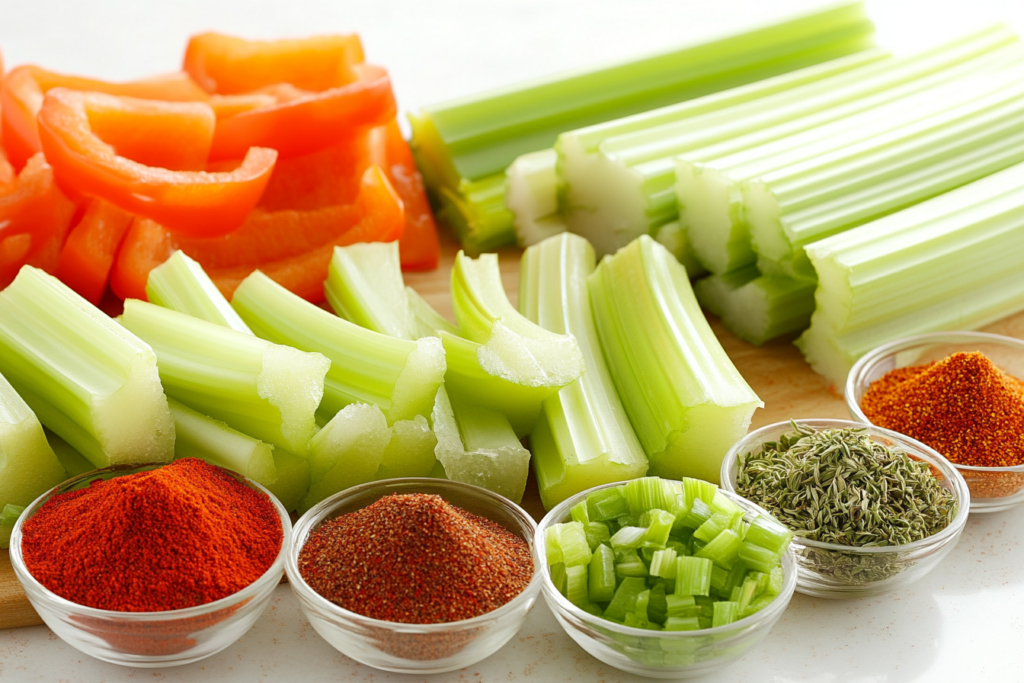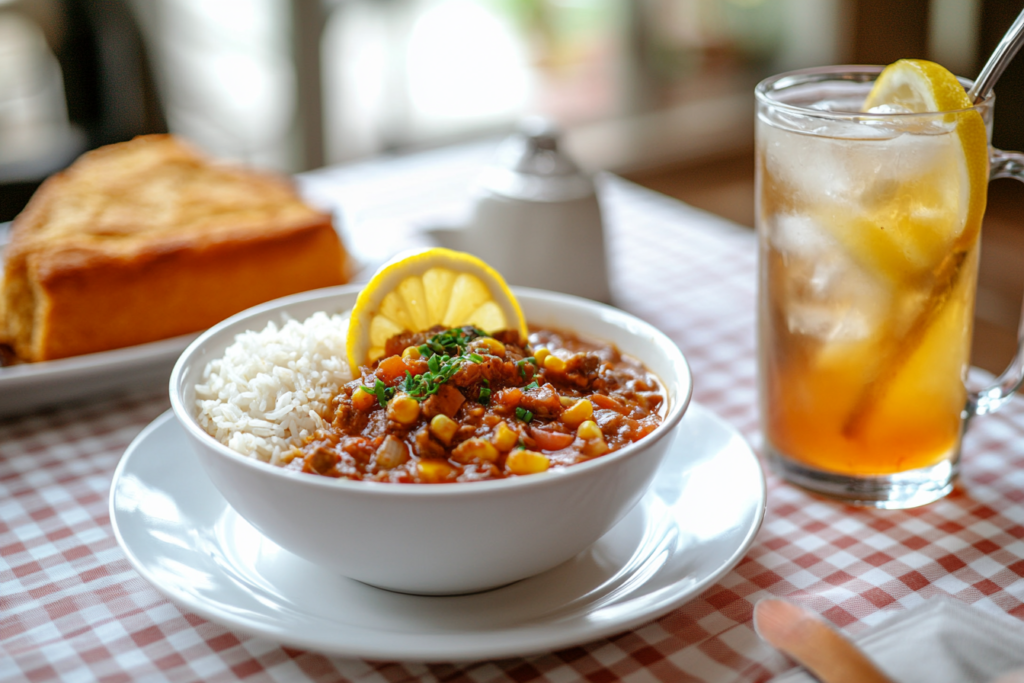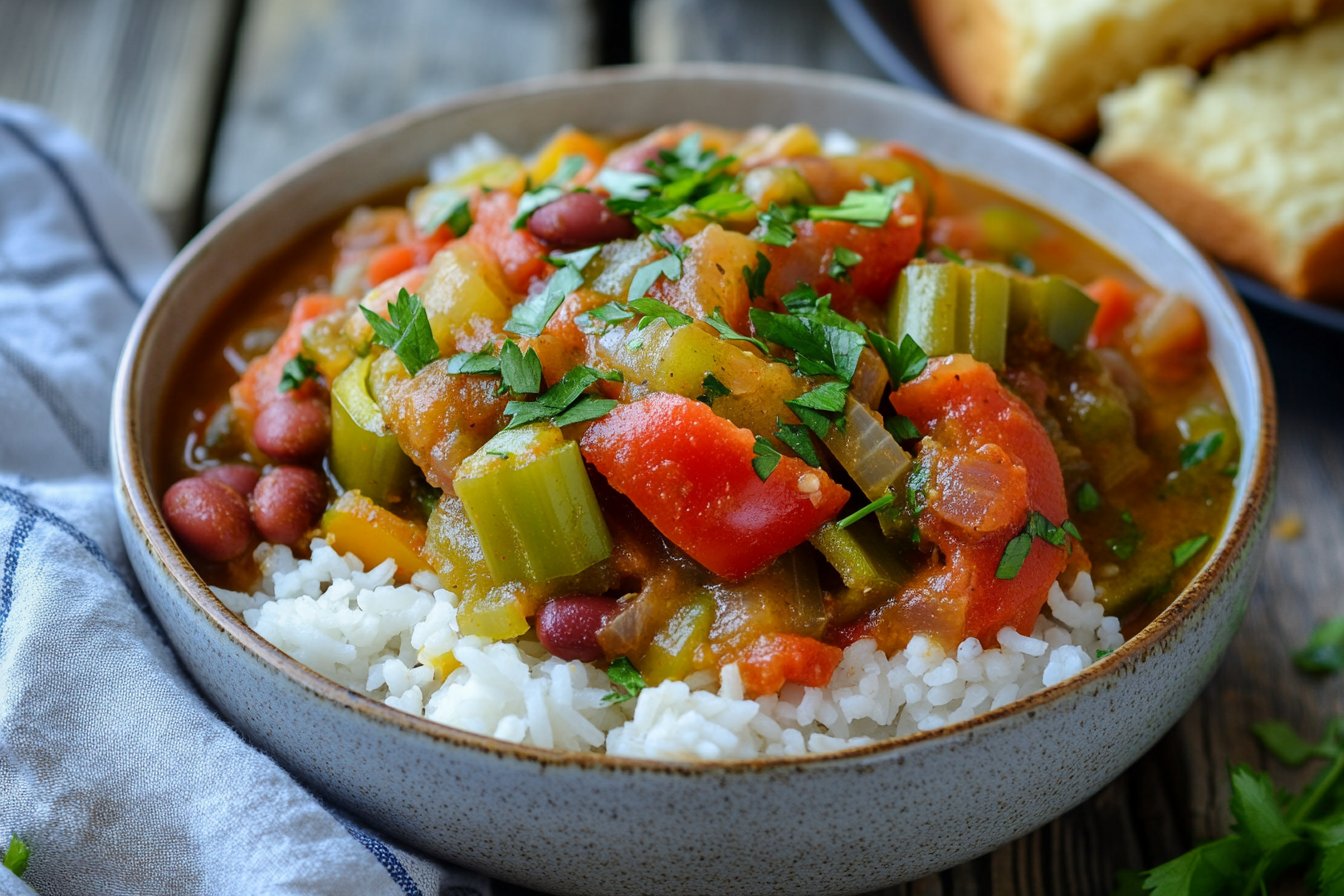Table of Contents
What Is Gumbo? A Brief History of the Iconic Dish
Gumbo’s Roots in Southern Cuisine
Gumbo traces its origins to Louisiana, where it’s a staple of Creole and Cajun cooking. The name “gumbo” is believed to come from the West African word ki ngombo, meaning okra—a key ingredient in traditional recipes. Over time, gumbo evolved, blending African, French, Spanish, and Native American influences into one unforgettable dish.
While traditional gumbo often features meat or seafood, its essence lies in the rich, thick broth and the perfect balance of spices and ingredients. This makes it an ideal candidate for a vegetarian makeover!
How Traditional Gumbo Evolved Over Time
The beauty of gumbo lies in its adaptability. Historically, cooks used whatever ingredients they had on hand, leading to countless variations. From shrimp and sausage gumbo to chicken and okra versions, the dish has evolved to cater to different tastes and cultures. But at its heart, gumbo is all about flavor and community—two things that resonate deeply with vegetarian cooking.
By skipping the meat and focusing on fresh vegetables, plant-based proteins, and vibrant seasonings, vegetarian gumbo stays true to the spirit of the dish while offering a healthier, more inclusive option
Why Choose a Vegetarian Version of Gumbo?
Health Benefits of a Plant-Based Gumbo
Switching to a vegetarian gumbo isn’t just about catering to dietary preferences; it’s also a fantastic way to boost your health. Vegetarian gumbo is a guilt-free indulgence, packed with nutrient-dense veggies, fiber-rich beans, and heart-healthy spices. Plus, it’s lower in cholesterol and saturated fats than its meat-heavy counterparts.
Environmental Impact of Choosing Vegetarian Dishes
Did you know that adopting vegetarian meals can significantly reduce your carbon footprint? By choosing a meatless gumbo, you’re contributing to a more sustainable planet. Agriculture for plant-based foods uses far fewer resources than livestock farming, making every bowl of vegetarian gumbo a win for the environment.
Addressing Common Misconceptions About Vegetarian Gumbo
“But doesn’t gumbo need meat to taste good?” That’s a question we always hear; the answer is a resounding no! The depth of flavor in gumbo comes from its base—a roux—and the careful layering of spices and ingredients. A well-made vegetarian gumbo is as satisfying as the traditional version and will surely win over even the most skeptical eaters.
Key Ingredients for a Perfect Vegetarian Gumbo

The Holy Trinity of Gumbo: Bell Peppers, Onions, and Celery
No gumbo is complete without the holy trinity of Cajun cooking. These three ingredients form the aromatic base of the dish, infusing every bite with warmth and depth. The onions’ sweetness, the celery’s earthiness, and the bell peppers’ crispness create the perfect foundation for your vegetarian gumbo.
The Role of Okra and Its Magical Thickening Power
Okra isn’t just an ingredient; it’s a game-changer. Known for its natural thickening properties, okra gives gumbo its signature texture. Don’t worry if you’re not an okra fan—there are alternatives like file powder or cornstarch, but trust us, okra deserves its moment in the spotlight.
Spices and Seasonings That Bring Gumbo to Life
Spices are the soul of any gumbo. Think paprika, thyme, cayenne, bay leaves, and a dash of hot sauce for good measure. The key is to taste as you go, ensuring your gumbo has the perfect balance of heat and flavor.
Plant-Based Protein Options: Beans, Tofu, and Beyond
Who needs sausage when you’ve got options like kidney beans, chickpeas, or even tofu? These plant-based proteins add texture and soak up the spices, making every bite a burst of flavor. For an authentic touch, smoked paprika or liquid smoke can mimic the smokiness of traditional gumbo.
Step-by-Step Recipe for Vegetarian Gumbo
Now that we’ve explored the history and essential ingredients, let’s roll up our sleeves and start cooking! Making vegetarian gumbo isn’t just about following a recipe—it’s about creating a dish that feels like a warm hug in a bowl. So grab your apron, and let’s get started.
Preparing Your Ingredients: Chopping, Sautéing, and More
The secret to great gumbo is preparation. Here’s what you’ll need:
- Vegetables: Bell peppers, onions, celery, okra, and tomatoes.
- Proteins: Kidney beans, chickpeas, or tofu (choose your favorite).
- Seasonings: Paprika, thyme, cayenne, bay leaves, garlic, salt, and pepper.
- Broth: Vegetable stock for a flavorful base.
- Roux Ingredients: Flour and oil (olive or vegetable oil works best).
- Chop your veggies: Dice the bell peppers, onions, celery, and tomatoes into small, even pieces. For the okra, slice it into thin rounds.
- Prepare your protein: If using tofu, press it to remove excess water, then cut it into cubes. Rinse and drain beans thoroughly.
- Gather your spices: Measure out your seasonings ahead of time. This will make it easier to layer the flavors as you cook.
Making the Perfect Roux Without Butter or Meat Drippings
The roux is the heart of gumbo—it gives the dish its rich, nutty flavor. Making a vegetarian roux is easy but requires patience.
- Heat ½ cup of oil in a large pot over medium heat.
- Gradually whisk in ½ cup of flour, stirring constantly.
- Keep stirring for 10–15 minutes or until the roux turns a deep caramel color.
Combining Ingredients to Achieve That Gumbo Flavor
Once your roux is ready, it’s time to bring the gumbo to life:
- Sauté the holy trinity: Add your chopped bell peppers, onions, and celery to the roux. Sauté for 5 minutes until the veggies soften.
- Add okra and garlic: Stir in the okra and minced garlic, letting them cook for another 5 minutes.
- Pour in the broth: Slowly add 6 cups of vegetable stock, whisking to combine with the roux.
- Add tomatoes and spices: Toss the diced tomatoes, bay leaves, thyme, paprika, cayenne, salt, and pepper. Stir well.
Cooking Times and Adjustments for Different Tastes
Simmer your gumbo over low heat for about 45 minutes. This allows the flavors to meld together beautifully. Add your protein (beans, chickpeas, or tofu) during the last 15 minutes of cooking.
Taste your gumbo as it simmers. If you need more heat, add a dash of hot sauce. If you want it thicker, let it simmer uncovered for an extra 10 minutes.
Common Problems and Solutions When Making Vegetarian Gumbo
Every cook faces challenges, but don’t worry—we’ve got you covered.
How to Avoid a Watery Gumbo
A watery gumbo can be a letdown, but it’s easy to fix. If your gumbo lacks thickness:
- Add a slurry of cornstarch and water (1 tablespoon each).
- Simmer uncovered to let excess liquid evaporate.
- Ensure your roux is thick enough to start with.
Fixing Gumbo That’s Too Spicy
Oops, did the Cayenne get a little heavy-handed?
- Add a splash of unsweetened coconut milk or cream to balance the heat.
- Stir in a dollop of plain yogurt.
- Serve over extra rice to dilute the spice.
Adding More Depth to Vegetarian Gumbo Without Meat
To create a deeper, smokier flavor:
- Use smoked paprika or liquid smoke.
- Add a dash of soy sauce or tamari for umami.
- Roast your vegetables before adding them to the gumbo.
Serving Suggestions and Side Dishes for Vegetarian Gumbo

What’s a hearty bowl of gumbo without the perfect accompaniments? Pairing your vegetarian gumbo with the right sides and drinks elevates the meal from good to unforgettable
Perfect Pairings: Cornbread, Rice, and More
- Rice: Gumbo is traditionally served over white rice, but you can switch it up with brown rice, quinoa, or even cauliflower rice for a low-carb option.
- Cornbread: A slice of warm, buttery cornbread is the perfect partner to soak up all that flavorful gumbo broth.
- French Bread: A crusty loaf of French bread works just as well for dipping.
- Collard Greens or Coleslaw: These sides bring a fresh, tangy contrast to the rich gumbo flavors.
Drinks That Complement Gumbo’s Bold Flavors
The bold, spicy notes of gumbo call for refreshing beverages:
- Sweet Tea: A Southern classic that balances the heat.
- Beer: A cold, crisp lager or pale ale pairs beautifully with gumbo.
- Wine: A chilled white wine, like Sauvignon Blanc, or a light red, like Pinot Noir, enhances the dish’s complexity.
Tips for Storing and Reheating Gumbo
Made too much gumbo? No problem! Gumbo tastes even better the next day as the flavors have more time to meld together.
Freezing Vegetarian Gumbo for Later
- Cool it down: Let your gumbo cool completely before storing.
- Portion it out: Divide it into freezer-safe containers or bags for individual servings.
- Label and date: Mark each container to keep track of freshness.
- Freeze: Gumbo can be frozen for up to 3 months without losing quality.
Reheating Without Losing Flavor or Texture
- On the Stove: Heat gently over medium-low heat, stirring occasionally. If it’s too thick, add a splash of vegetable stock.
- In the Microwave: Use a microwave-safe dish, cover loosely, and heat in 1-minute intervals, stirring in between.
Variations of Vegetarian Gumbo You Should Try
One of the best things about gumbo is its versatility. You can tweak the recipe to suit your dietary needs or experiment with unique flavors.
Gluten-Free Vegetarian Gumbo
- Use gluten-free flour or arrowroot powder for the roux.
- Double-check that your broth and seasonings are gluten-free.
Spicy Cajun-Style Gumbo
- Crank up the heat with extra cayenne and hot sauce.
- Add Cajun seasoning for a bolder flavor profile.
Vegan Gumbo with Unique Ingredients
- Skip any dairy or eggs entirely (though our recipe is already vegan-friendly!).
- Add jackfruit for a meaty texture or seaweed for a hint of seafood-like flavor.
FAQ
What are the 2 rules of gumbo?
The two golden rules of gumbo are:
The Roux Must Be Right: A well-made roux is the foundation of gumbo’s flavor. It should be cooked slowly and stirred constantly until it reaches a deep caramel or chocolate color.
Layer Your Flavors: Gumbo is all about building depth. This means sautéing the holy trinity (onions, bell peppers, and celery), using the right spices, and letting the flavors meld together as it simmers.
What is a substitute for chicken broth in gumbo?
For a vegetarian gumbo, you can use:
Vegetable broth: A flavorful and widely available option.
Mushroom broth: This adds a rich, umami taste.
Homemade stock: Simmer leftover vegetable scraps with herbs to create a custom broth.
What are the three types of gumbo?
The three primary types of gumbo are:
Seafood Gumbo: Made with shrimp, crab, or other seafood, often paired with okra.
Chicken and Sausage Gumbo: A popular version featuring smoked sausage and chicken.
Vegetarian Gumbo: Focused on vegetables, plant-based proteins, and bold seasonings while staying true to gumbo’s rich flavors.
Final Thoughts
Vegetarian gumbo is a versatile and delicious dish that even beginner cooks can master. If you’re new to plant-based cooking, check out our guide to Plant-Based Recipes for Beginners for helpful tips. For those interested in exploring even more options, our Vegan Recipes for Beginners post offers inspiration for crafting delicious vegan meals. Pair it with a side from our Homemade Bread Recipe to complement your gumbo for a hearty and satisfying addition. If you’d like to experiment with plant-based proteins like tofu, look at our Chick-fil-A Veggie Wrap recipe, which showcases creative ways to enhance texture and flavor.

